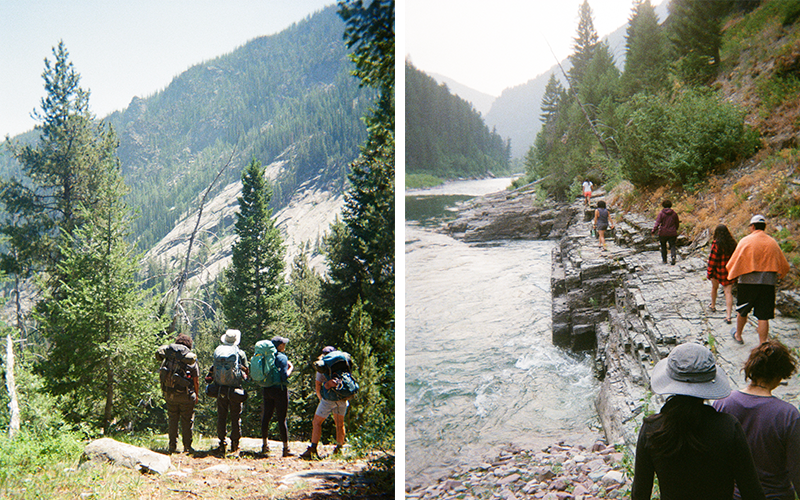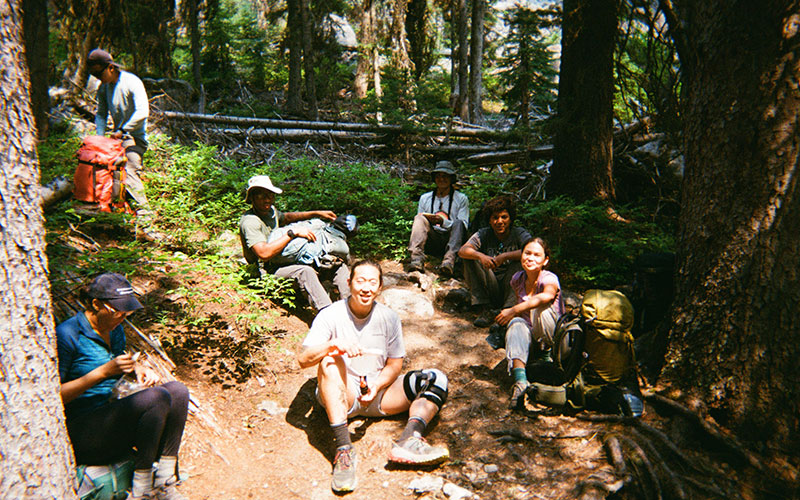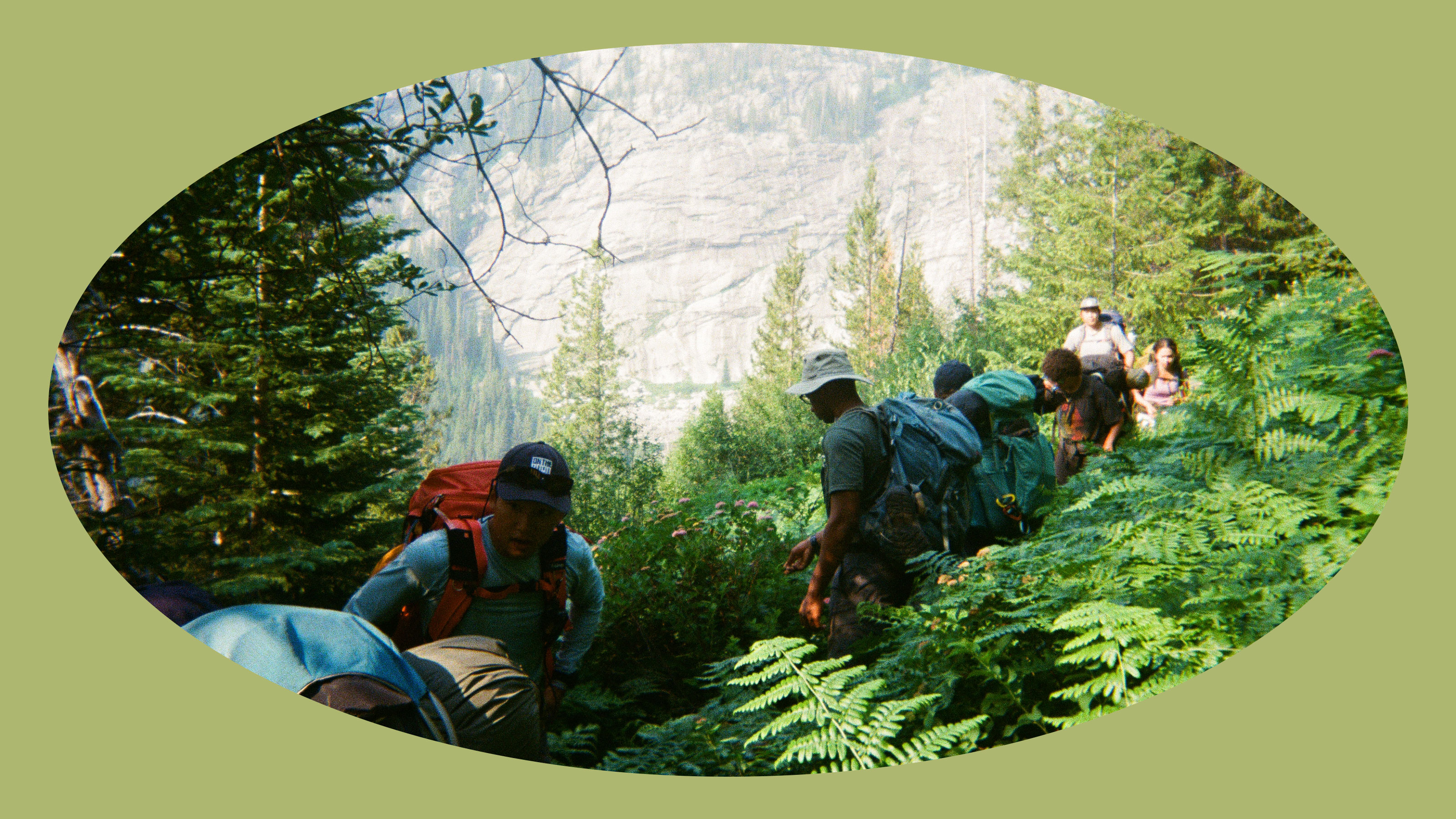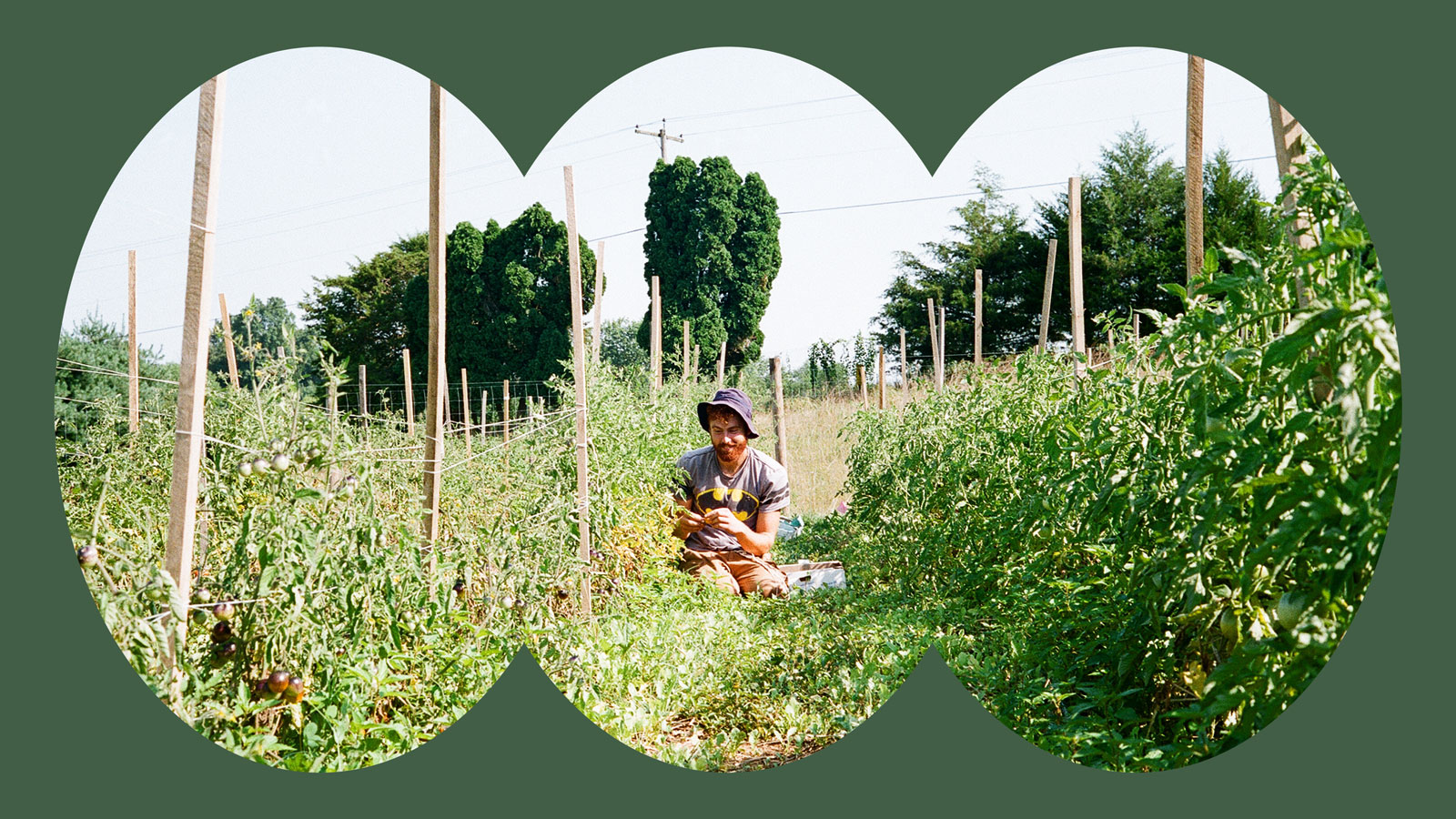This story is part of Fix’s Outdoors Issue, which explores how we build connections to nature, why those connections matter, and how equitable access to outside spaces is a vital climate solution.
This post has been updated.
Alex Kim’s background isn’t typical among his peers in outdoor recreation. He didn’t grow up rafting each summer, mountain biking after school, or camping with friends — activities long considered unofficial prerequisites to work in the field.
As a first-generation Korean American kid in the suburbs of Washington, D.C., Kim’s childhood was marked by vastly different experiences, such as helping his mother translate citizenship paperwork, spending afternoons swimming at the YMCA, and playing basketball with kids from the neighborhood.
Nothing about Kim’s childhood suggested he would become an avid outdoors enthusiast until he arrived in Montana in December 2014, the last stop on a months-long, cross-country roadtrip. He was 23 and had just spent four years in the Army, and after so regimented a lifestyle, the idea of living out of his Subaru while exploring wide-open spaces was appealing. He made it as far west as Arizona before tacking north and landing in Missoula, a place he meant to make nothing more than a stopover on his way to Glacier National Park.
He never left. Drawn by the region’s rugged beauty, Kim decided to build a life in a state nicknamed the Last Best Place. He studied journalism and photography at the University of Montana, and developed not only a love of, but a proficiency in, outdoor sports. Before long, he became a certified rafting guide and started exploring the wilderness that surrounds the city. It struck him how few people looked like him on the trails or the river. People often asked racially coded questions about his presence: Why does this interest you? Do you know what you’re doing out here? Where are you from?
“I realized the importance of environment and space and the people I chose to hang out with, and the differences in the conversations,” Kim says.
Tucked in the valley of the northern Rockies, Missoula boasts 550 acres of city parkland and 4,200 acres of conservation area off-limits to development. It sits at the convergence of five mountain ranges and the Clark Fork, Bitterroot, and Blackfoot rivers. Surrounded on all sides by towering foothills, adventurous hikers can climb thousands of feet up narrow trails that meander from the edge of town through forests and ridgelines. Each summer, the Clark Fork River, which cuts through the city, teems with fish, anglers, and people on paddle boards and inner tubes.
Missoula is, by all counts, a dream for anyone who loves the outdoors. Yet, as is true everywhere, decades of systemic racism and overt discrimination have built metaphorical walls around public lands and outdoor recreation that make many people feel excluded.
This reality isn’t unique to Missoula, of course. Close to 70 percent of people who visit national parks and forests are white, despite accounting for 58 percent of the U.S. population. These numbers are mirrored by the outdoor recreation industry, where 72 percent of participants in 2020 identified as white.
In 2019, Kim approached the city’s parks and rec department with a proposal: Let’s create a program that provides people of color with the opportunities, resources, and expertise to enjoy the outdoors. The city embraced the idea, hired Kim, and found the money to make it work.
The program’s first event was a free cross-country ski outing in January 2020. Since then, Kim and a small band of volunteers have taken dozens of people rafting, hiking, and camping, creating a model for other communities eager to bring diversity and equity to the outdoors.
Kim named the program Here Montana, which reflects its simple mission. “It’s just to be here,” he says. “We’re here, and we’re happy to be here.”
* * *
City hall wasn’t Kim’s first stop when floating his idea for what would become Here Montana. While working at the Missoula branch of Backcountry Hunters and Anglers, a nationwide nonprofit focused on backcountry hunting and fishing, Kim led a rafting trip for people of color. The response was overwhelmingly positive, and Kim knew he had tapped an unmet demand within Missoula. Drawing from his belief that open space is a public good, Kim approached city officials. He hoped they would put money behind the county’s stated values of equity and diversity, and allocate the resources needed to help BIPOC residents feel welcome within outdoor spaces.
“We were so stoked and so excited,” says Meg Rogosienski Whicher, the outdoor recreation manager for the city’s parks and recreation department. “What Alex brought was representation, passion, and direct connectivity.”

Though the program is run by the city, in many ways it functions like a partnership: The parks department provides equipment, insurance, vehicles, and other support, while Kim connects with Missoula’s communities of color to invite them on trips, many of which he guides. Over the past two years, Kim has led whitewater-rafting trips and multiday backpacking trips with wilderness researchers during the summer. Come winter, he’d take people cross-country skiing and snowshoeing.
Of the department’s roughly $9.1 million annual operating budget, just shy of $5,000 was allocated to Here Montana for the current fiscal year, Whicher says. That’s less than half of what the city has provided in past years, a reduction that was made because the program applied for, and received, grants and donations for the bulk of its $18,000 budget.
Kim is the sole employee, and a part-timer at that. Until recently, he held down several side gigs to make a comfortable living. That’s not unusual, Whicher says, as full-time positions are difficult to create and many of her employees work part-time. That said, the city offers Here Montana activities free of charge, relying on revenue from other parks and recreation programs to subsidize the cost.
“I say that because I want to show the priority that’s been given to reduce barriers,” Whicher says.
* * *
Achieving equity is a journey, not a destination, of course, and everyone concedes Here Montana has more work to do. But few would deny the positive impact it’s had.
Pablo Luna grew up in San Diego in a tight-knit Latino community. He played soccer and other sports, and rarely felt out of place. After moving to Missoula a little less than two years ago, Luna immediately noticed that “people’s gazes linger longer” when they pass him on the street, and he’s acutely aware of his recurring role as the only person of color in any given space — including the outdoors.
He’s taken up mountain biking, and can tell stories of passing Confederate flags on the way to trailheads. Luna says he sometimes feels like some people actively dissuade people of color from feeling comfortable. Traveling in a group with Here Montana helps ameliorate that discomfort, and Luna says he would venture into the backcountry less often if not for the organization. He attends as many trips as he can, because he finds comfort in being with folks who look like him. “It takes a weight off your shoulders,” he says.

Kellie Carim, who grew up in St. Paul, Minnesota, had the same reaction. She’s a competitive cross-country skier, and long ago grew accustomed to being the only person of color on the trails. She still skis competitively, and as a research ecologist, Carim is no stranger to the wilderness. Yet she feels outdoor spaces aren’t meant for people like her. She didn’t realize the emotional toll that had on her until she started leading ski trips for Here Montana.
“I’m used to being the brown person on the trails, and to come to a Here Montana event [feels] like weight that I didn’t know I was carrying is gone.”
— Kellie Carim, cross-country skier
“I didn’t think I would personally get as much out of it as I did,” she says. “It’s this sense of community that is so important. I’m used to being the brown person on the trails, and to come to a Here Montana event [feels] like weight that I didn’t know I was carrying is gone.”
Here Montana also helps eliminate some of the tangible barriers that BIPOC people must overcome to safely venture into the outdoors. Equipment is a major obstacle — and so the city provides it all free of charge for every outing — but the lack of generational knowledge is a more subtle, yet similarly debilitating, hurdle to clear.
Adults who weren’t exposed to the outdoors as kids are far less likely to participate in outdoor recreation once they grow older. But youth participation in such activities is overwhelmingly white and affluent. Knowledge of where to go, what kind of gear to use, how to be safe, and what to do if something goes awry typically isn’t passed down between generations within many families of color. Here Montana gives BIPOC adventurers that kind of guidance.
“It really just provides all the access, all the knowledge, and all the tools to be comfortable with the people around you in order to get outside,” Luna said. “Here Montana almost provides you a mentor, someone you can relate to.”
* * *
Missoulians have largely embraced the program. But Kim says he’s heard some pushback about whether parks and rec should fund something that serves a sliver of the city’s population. The question gets at a core tension in local government’s mission: Should taxpayer dollars be used to serve the greatest number of people, or to help build equity?
Whicher believes Missoula, where 10 percent of the city’s 75,000 residents are people of color, has an obligation to do both. Roughly 15,000 people participate in parks and recreation programs each year, according to Whicher. Yet Here Montana, which serves about 150 people, is just one of two that is offered at no cost to residents.
In some ways, this aligns with the city’s stated goal of creating a just and inclusive place to live. The plan for achieving that includes allocating resources to communities based on their need, rather than simply giving everyone the same amount of support. Whicher says she strives to balance “the percentage of the population that could be served” and equity values when evaluating recreation programs. “To be a true municipal program means that I need to figure out how to make it work for everyone,” she says.
Even as some argue the city is doing too much to support Here Montana, some of the program’s supporters insist it isn’t doing enough. They note that it lacks the resources to meet the demand Missoula’s BIPOC community has shown for outings, which Kim says invariably fill to capacity. They also say Here Montana needs a full-time director dedicated solely to this work, rather than a part-timer squeezing it in around other jobs.
“Don’t just fund it so it can get done,” Luna says, noting that a full-time hire would make a huge difference. “Fund it because you care and you want it to be done the right way.”
Other cities would make their own determination about the fair use of taxpayer dollars when it comes to hiring and program support, but Whicher says Missoula has largely made its call on the matter: A full-time position devoted to outdoor recreation exclusively for adults is improbable, but there’s talk of potentially hiring a position to support diversity and equity across department-wide programming, including Here Montana.
Such conflicts are common in a new organization, and it’s rare to find a municipal program that doesn’t want additional funding. The real measure of success is not the absence of these discussions, but whether an initiative can outlast its creator.
Here Montana is about to find out. Kim departed his role as program coordinator at the end of March and will soon begin a full-time role leading the city’s diversity and equity work. Kim is excited by the new opportunity, and wants to encourage more people of color to apply for leadership positions within city government and show his colleagues that less traditional candidates can succeed.
His departure concerns Here Montana’s advocates, who worry the infrastructure behind the program hasn’t received enough support to survive without Kim. They also fear he will be replaced by someone who lacks the passion, hustle, and connections with Missoula’s BIPOC community that keeps it afloat.
According to Whicher, hiring a person of color as Kim’s replacement is “vital” and “essential,” but she did not say how the city is identifying candidates. Until parks and rec finds a replacement for him, Here Montana will be without its backbone, and it’s likely to look significantly different as a result. Whicher acknowledges the void, but says the department plans to devote resources to recreation opportunities for BIPOC community members until Kim’s replacement is found.
Achieving equity in outdoor access remains a challenge cities everywhere struggle to overcome. It’s a problem the outdoor recreation industry has yet to solve. Supporters of Here Montana insist Missoula could pave the way for other municipalities that can use its existing framework as a starting point.
At this moment of transition for Here Montana, supporters are hopeful that city leaders recognize this potential and see it as the right thing to do for BIPOC in Missoula — and beyond.
“It feels good to do this. It looks good to do this, so lean into that, do it well, and be a role model,” Carim says. “We’re positioned at this time to be a leader in this type of thing. Look at all the good that could come out of this. It looks good for the city, it helps people in the city, it makes public land actually more equitable to the public and accessible.”
Explore more from Fix’s Outdoors Issue:
- An urban nature tour reveals how to find wild spaces, even in cities
- From kelp farming to ancient wayfaring: Restoring traditional land practices
- Disabled hikers deserve to enjoy the outdoors




